Actions taken since the 2008 financial crisis to address the federal government’s concerns about Canada’s housing market.
July, 2008:
• After briefly allowing the CMHC to insure high-ratio mortgages with a 40-year amortization period, then Conservative finance minister Jim Flaherty moved to tighten those rules by reducing the maximum length of an insured high-ratio mortgage to 35 years.
February, 2010
• Responding to concern that some Canadians were borrowing too much against the rising value of their homes, the government lowered the maximum amount Canadians could borrow in refinancing their mortgages to 90% of a home’s value, down from 95%.
• The move also set a new 20% down payment requirement for government-backed mortgage insurance on properties purchased for speculation by an owner who does not live in the property.
January, 2011:
• The Conservative government tightened the rules further, dropping the maximum amortization period for a high-ratio insured mortgage from 35 years to 30 years.
• The maximum amount Canadians could borrow via refinancing was further lowered to 85% of a home’s value.
June, 2012
• A third round of tightening brought the maximum amortization period down to 25 years for high-ratio insured mortgages.
• A new stress test was also introduced to ensure that debt costs are no more than 44 per cent of income for lenders seeking a high-ratio mortgage.
• Refinancing rules were also tightened for a third time, setting a new maximum loan of 80 per cent of a property’s value.
• Another new measure limited the availability of government-backed insured high-ratio mortgages to homes valued at less than $1-million.
• Limit the maximum gross debt service (GDS) ratio to 39% and the maximum total debt service (TDS) ratio to 44%.
December, 2015
• The recently elected Liberal government moved to tighten lending rules for homes worth more than $500,000, saying it was focused on “pockets of risk” in the housing sector.
• The package of measures included doubling the minimum down payment for insured high-ratio mortgages to 10% from 5% for the portion of a home’s value from $500,000 to $1-million.
October, 2016
• Borrowers who take out insured mortgages that are fixed-rate loans of five years or longer will be subjected to a “stress test,” by qualifying at the Bank of Canada’s Benchmark rate (then about 2% higher than a typical 5-year fixed rate). This same stress test is already in place for all mortgage terms of less than 5 years and for those taking a Variable Rate.
• Ottawa unveiled new measures aimed at portfolio insurance, a type of bulk insurance that banks use for mortgages with down payments of 20 per cent or more. Starting Nov. 30, the federal government will now require portfolio-insured mortgages to qualify under the same criteria used for the insurance taken out on homeowners with small down payments. Portfolio-insured mortgages will now be limited to a maximum amortization period of 25 years and a maximum purchase price of less than $1-million. It requires all portfolio-insured mortgages to be owner-occupied, prohibiting insurance on rental homes and investment properties. This change handed the banks a huge advantage over the Monoline mortgage lenders, and increased their market share and ultimately allowed the banks to increase mortgage interest rates.
January, 2018
• Home buyers with a down payment of 20% or more will be subject to stricter qualifying criteria (also known as a “stress test”) that would determine whether a homebuyer would be able to afford their principal and interest payments should interest rates increase. REFINANCING an existing property (20%+ Equity) will also be subject to the stress test. For qualification, the stress test will use either the 5-year benchmark rate published by the Bank of Canada or the customer’s actual mortgage interest rate plus 2.0%, whichever is the higher. Estimated reduction in borrowing for the average borrower, 15-20%
• OSFI directs lenders (excluding credit unions and private lenders) to have internal risk management protocols in higher priced markets (sometimes called “hot real estate markets” like Toronto and Vancouver). This is a continuation of a policy already in place. Many mortgage lenders have been following the principles of the policy for the last 10 to 12 months.
• Mortgage lenders (excluding credit unions and private lenders) are prohibited from arranging with another lender: a mortgage, or a combination of a mortgage and other lending products, in any form that circumvents the institution’s maximum LTV ratio or other limits in its residential mortgage underwriting policy, or any requirements established by law. This is often referred to as “bundling” or “bundle partnership”.
 All through human history, in one way or another, adults have cared for their elderly parents in some fashion, from sharing housing to food and financial assistance. What I am now seeing is that this is sometimes a triple-decker sandwich, with Boomers helping their parents, their grown children and their grown grand-children. The stats on this are surprising… Statistics Canada on the sandwich generation
All through human history, in one way or another, adults have cared for their elderly parents in some fashion, from sharing housing to food and financial assistance. What I am now seeing is that this is sometimes a triple-decker sandwich, with Boomers helping their parents, their grown children and their grown grand-children. The stats on this are surprising… Statistics Canada on the sandwich generation
